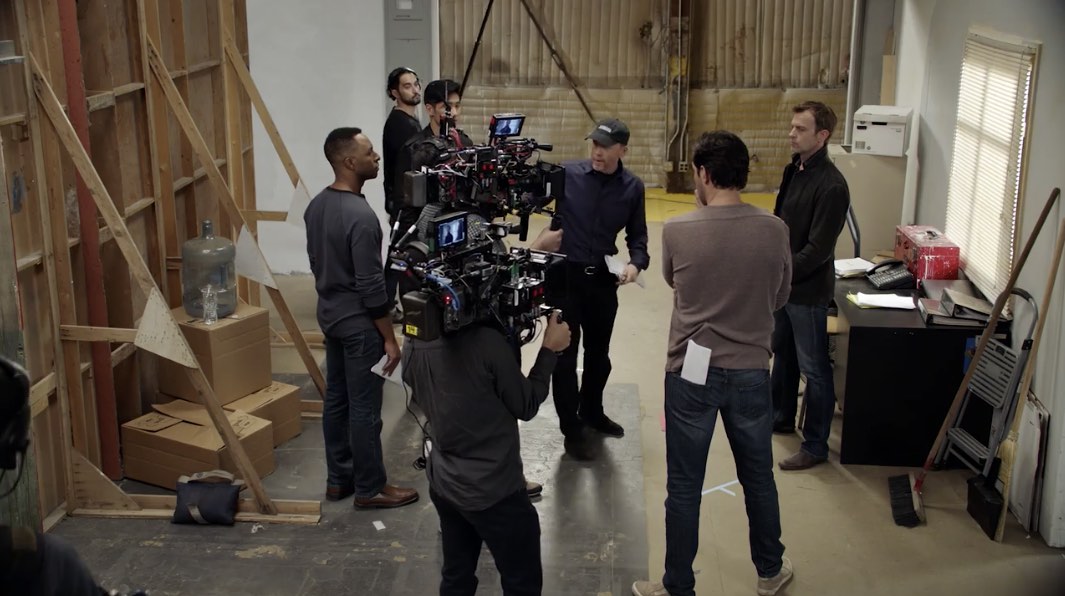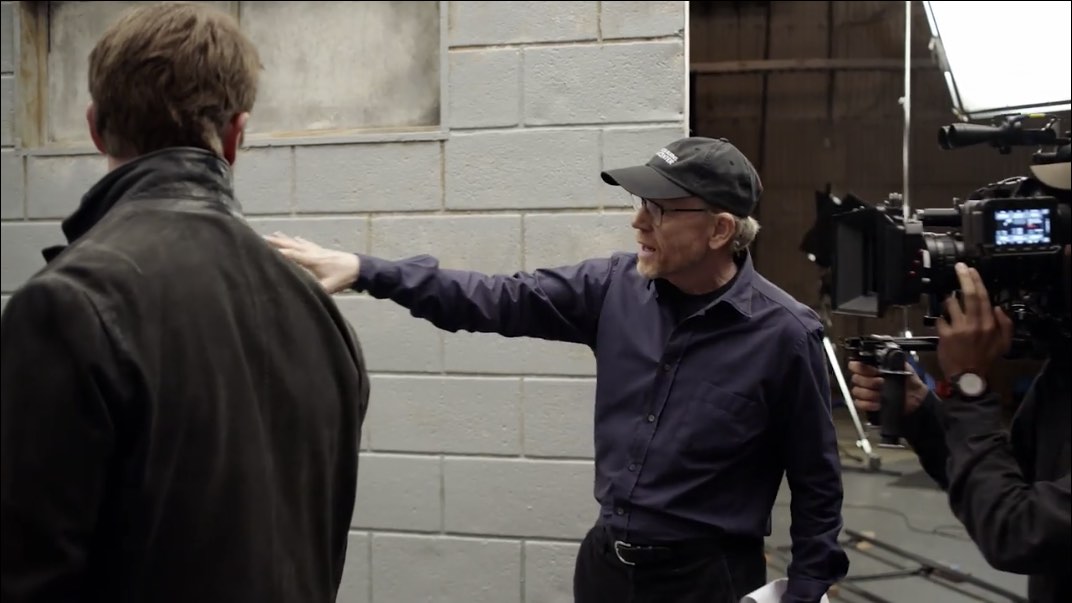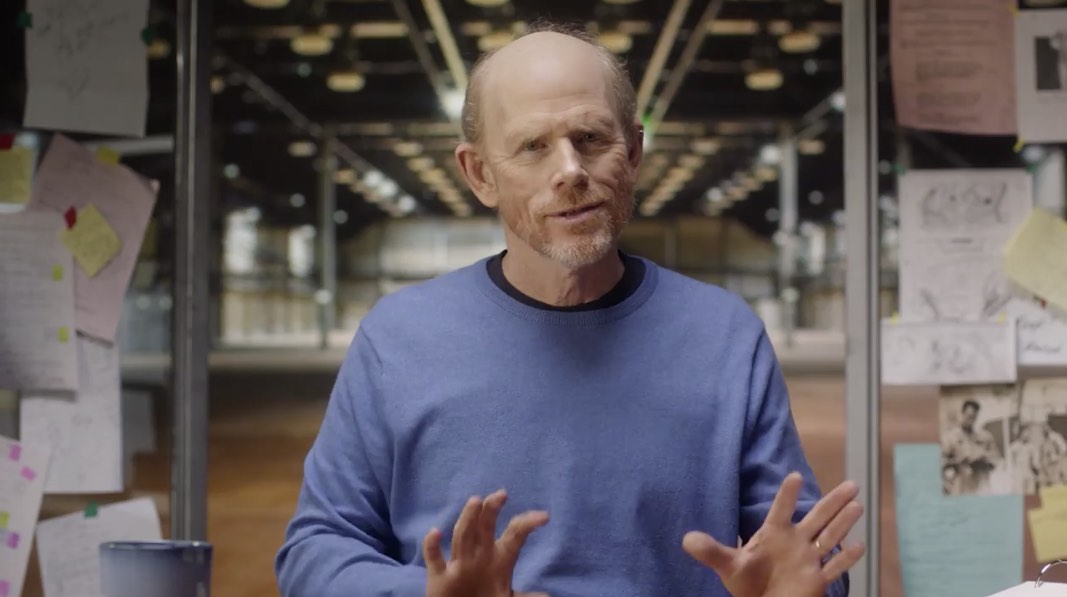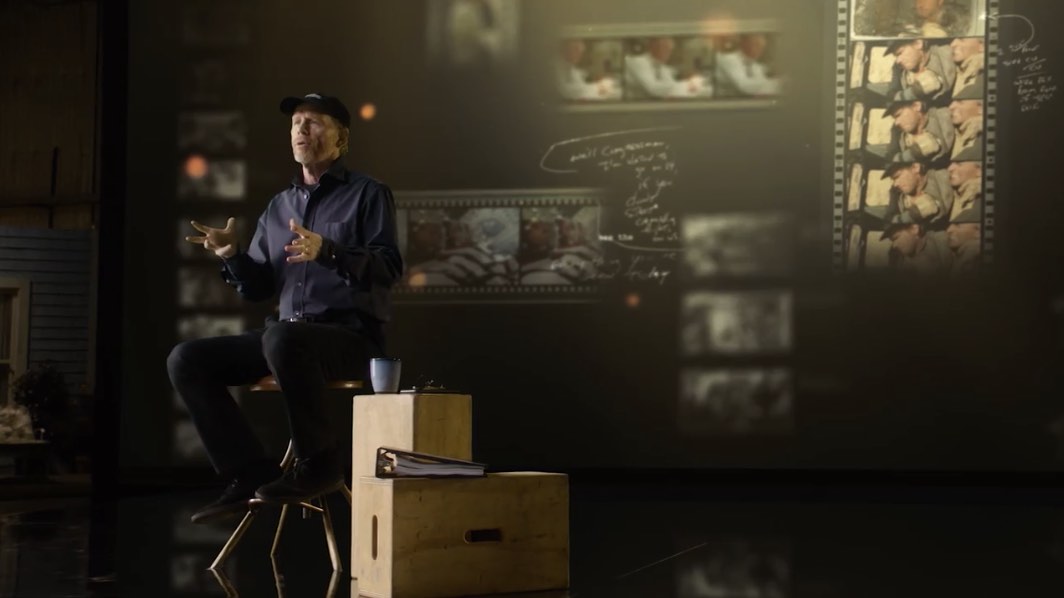Ron Howard Directing Masterclass Reviewed
Ron Howard’s Masterclass.com course on film directing is everything I hoped it would be.
To be honest, it’s everything I had hoped Martin Scorsese’s Masterclass would have been; a practical, insightful guide to directing a film from start to finish, replete with stand up, hands-on practical workshops, scene specific breakdowns and a fountain of filmmaking insights, wisdom and insider stories.
Having watched every single lesson of Ron Howard Teaches Directing on Masterclass.com, from start to finish, I’m confident you’ll find it as inspiring, thought provoking and confidence-building as I did!
With 32 unique lessons in the class, there is more than enough instruction to happily watch one a day for a month, enjoying a daily pep talk from Ron and emerge on the other side a far more confident and capable filmmaker.
But why should anyone who doesn’t want to be a director, say an editor, take this course in particular?
Here’s 3 quick reasons:
- The more you understand about the entire filmmaking process, the better equipped you are to master your specific contribution.
- Editors are a little like ‘mini-directors’; they need to understand actors and performance, story structure and rhythm, how to collaborate with other department heads and much more.
- Most importantly, they need to how to best serve their director, which starts with understanding how they think and feel, how they work and the challenges and pressures that they face.
All of these things are more than covered in Ron’s class and delivered with humility, humour and empathy, drawing as he does on a lifetime of experience in the craft.
Check it out for yourself on Masterclass.com
UPDATE June 2023 – Masterclass is now more affordable!
A new pricing tier, that works out to £10/month when billed annually, will save you £48/year compared to previous pricing of £14/month. The only difference is no downloads and 1 device.
What’s covered in the course?
Here’s a brief sampling of some of the lesson titles, to give you a flavour of what’s in store:
- Evaluating a script
- Working with Cinematographers
- Cinematography
- Production Design
- Working with Actors (Part 1+2)
- Editing (Part 1+2)
- Music and Scoring
The course also comes with a downloadable 40 page PDF workbook, which has summary notes on each lesson and suggested viewing and reading lists.
Another feature of most Masterclass.com courses is the Office Hours sessions which allow you to ask questions directly to the instructor, receive feedback on course assignments and generally get more from these masters of their craft.
So far Ron hasn’t had the time to do one of these, but it’s definitely an added bonus worth keeping an eye out for, which further extends the value of the course.
Some of my favourite lessons however where the practical and scene deconstruction lessons, including:
- Case Study: Frost/Nixon
- Scene Deconstruction: Raiders of the Lost Ark
- Scene Deconstruction: A Beautiful Mind
- Frost/Nixon: Feature Staging for Coverage
- Frost/Nixon: Staging for an Indie Shoot
In the Raiders of The Lost Ark scene deconstruction Ron plays the truck chase scene with no sound and describes how he uses this technique to learn about staging, scheduling, framing and efficiency from other filmmakers.
It was fascinating to hear how much he could ‘decode’ from various aspects of a shot based on years of production experience: “You can tell that’s second unit as the stunt-double is angling his face away.“
This technique of watching films silently, is a great thing for any filmmaker, and especially editors to do, as it helps you to take a step back and really evaluate how each shot is constructed, how each edit works with the next and techniques that you might be able to use in your own projects.
It’s just a better way of ‘watching what you are watching’, instead of being sucked into the flow of the scene itself.
There is an extensive 8-part series of lessons, clocking in at nearly 3 hours of viewing, which gives you the opportunity to be a fly on the wall of a film set, and learn how Ron directs a cast and crew whilst filming a specific scene from his film Frost/Nixon.
Aside from the numerous other hours of listening to Ron teach you about filmmaking, these three would be worth the price of admission alone.
Where else do you get to see an experienced director run a film set, direct a crew, create and pick up coverage as well as re-run the whole thing under specific creative constraints, such as if he were only using a Steadicam or working with a limited amount of time and money?
As an editor it’s also really interesting to see and learn more about the on-set choices that will affect what you have to work with in the edit suite, and some of the reasoning behind those decisions.
Masterclass.com are beginning to share short nuggets (one a day I believe) from their library of instructors. Here is Ron on the subtle art of collaboration as a director; knowing when to listen and when to lead.
What an editor can learn from Ron Howard’s Directing Masterclass
As a film editor I learned a lot from Ron’s course, not only about directing and filmmaking in general, but also insight immediately applicable to the craft of film editing too.
In my month of viewing, I was often surprised how much time went by in each sitting. Ron was thoroughly engaging to listen to for extended, multi-lesson viewing sessions.
In retrospect this was probably because each lesson was packed with wisdom on the nitty gritty of filmmaking; hitting deadlines, staying within budget, learning from other filmmakers, the business/relationship side of things, as well as insights on the pure craft of cinema.
The following thoughts are sort of in the order of the course, based on the notes I made as I went through the course.
Scripts, Story and Selection
In the lesson on Evaluating a Script I thought Ron’s checklist for reviewing the quality of a script was insightful, questions like:
- Are the characters interesting?
- Who is in conflict?
- Is it a page turner?
- Is there a thematic narrative question?
- Is it being answered?
- Was the ending expected?
- Does the script have any fatal flaws?
Being able to evaluate your edit with these questions would prove just as fruitful, when considering the question of ‘is it working?’
Part of the answer will be down to your gut instinct and how others are reacting to the material on an emotional level, but diagnosing problems might be aided by asking these kinds of questions.
Ron also suggested a short list of books you might want to delve into for some further reading on the subject of screenwriting, story construction and similar topics:
- The Art of Dramatic Writing by Lajos Egri
- Making a Good Script Great by Linda Seger
- Story: Substance, Structure, Style, and the Principles of Screenwriting by Robert McKee
Ron also shares some great personal anecdotes on why he choose projects, how he sustains that initial spark and how he develops the projects he takes on.
Dealing with the Pressure
In reality, the editing room is where the film is made, but you can’t think about it at that point.
This quote comes from a moment in the course where Ron describes how to deal with the pressures of production compromises and challenges on set.
It was really interesting to hear him consider the interplay of different departments, and their respective heads, and how as a director you need to corral them into a team dynamic.
For example, Ron highlighted the tension that can appear between a Production Designer and a Director of Photography, when the DP is feeling pressure to make every scene look amazing, but they can only work with what they’re given (to a certain extent) by other departments. And so understanding and foreseeing that, that relationship can come under strain helps you to nip those issues in the bud.
To my mind it’s likely that similar issues could occur between Editors and Sound Designers, Composers or VFX Supervisors.
Either way, having empathy for the responsibility others are carrying can help you help them, by doing your job with a team mentality at hand.
Speaking of empathy, one of Ron’s suggestions to fellow directors is to take acting classes, so that you know what it feels like to be put on the spot and have to deliver the goods. To experience stage fright and have to be vulnerable with your emotions in front of others.
He also spoke at length on the crucial importance of casting, and how he navigates that part of the filmmaking journey. Ron shared excellent insights on how to solve problems with actors on set, understanding how different actors think and how they respond best to direction.
The lessons on casting deliver a really nuanced and informative discussion from an experienced director. Fascinating stuff.
As this relates to editing, it’s also the editor’s job to protect the actors and to mine their takes for the very best performance you can.
This means understanding what you need to look for if actor A tends to be better in the early takes whilst Actor B tends to improve over time.
And what to do with Actor C who loves improvising and is entirely different in every take – all in the same scene!
Building Sequences not just Scenes
I build sequences in 10 minute chapters. I try to identify that rhythm within the script, and in addition to the over-arching structure of the movie, I try to make sure there are these chapters.
That they have their own beginning middle and end. They carry their own narrative questions, what will happen next?
Of course, your playing out the larger plot all the time, but on a specific level, you’re concerned about these other particulars, that create some tension, some curiosity and have a climax.
In lesson 16 in which Ron deconstructs several scenes from A Beautiful Mind, he shared this thought about how he believes its the director’s job to create sequences of scenes, each with a beginning, middle and end – creating climaxes at several points in the film, and not just thinking of each scene individually.
In the example from A Beautiful Mind the film switches to the point of view of John Nash’s wife’s perspective for one chapter or 10 minute sequence.
It’s an editor’s job to structure and create these movements and rhythms through a film too.
[You should be] not just looking at one scene after the other, as it’s own discrete set of creative ideas and writing and acting problems, but trying to bundle things together and create a kind of a flow and an emotional connection that is building and crashing down – emotionally, and then you begin again, with a new narrative question.
What next?
Those kind of things, create emotional investment for audience, they also help you define ‘highlight scenes’.
Most directors would say your movie is built on a handful of highlight scenes… they’re usually a pay off to a sequence. Billy Wilder said you have to understand your five important scenes and know how to build to them.
During a course a movie there is not just one climax at the end, there’s meant to be a lot of spikes, and it’s the directors job to identify it and make sure you don’t under play those, and that also in the aftermath of one of those moments you give the audience a breath.
You understand that you’ve just completed one sequence with it’s own climax and give yourself a moment to collect yourself, and wonder what’s going to happen next and then move into it with the characters.
I think this is a great concept for editors to keep in mind, and also helps you to focus on building and blending transitions between scenes so that the sequence works as a whole.
On the subject of legendary director Billy Wilder (Some Like It Hot, The Apartment, The Odd Couple etc.) if you’re a fan, you must read director Cameron Crowe’s superb book: Conversations with Wilder.
This is one of my all-time favourite filmmaking books, and I’ve previously reviewed it here.
A well written scene shot with a wide, medium and two close ups can’t fail. – George Lucas
At the end of Ron’s lesson in which he reviews all of the preceding lessons on staging the Frost/Nixon scene, he shared this helpful quote from his friend (and director) George Lucas.
Explaining that, at the end of the day, if you’re running out of time, ideas and energy you don’t always have to re-invent the wheel.
This is also true for editors. If you have a well written and acted scene shot simply with a wide, medium and two close ups, you have all you need to cut something great that will carry the story.
Final Thoughts
If you haven’t already guessed I LOVED Ron Howard’s Teaches Directing.
It’s an excellent way to gain a solid practical understanding of the art, craft and real day-to-day work of being a director. You’ll learn how to harness the camera, marshal the resources of each department, create collaborative engagement with actors and key personnel and so much more.
Although I would have appreciated the same depth of insight on the editing side of things, as there was for the on-set staging of a scene from Frost/Nixon, the numerous and intelligent scene breakdowns more than made up for it.
Ron had something wise and helpful to say on almost every subject.
How would you handle speaking to an actor who is freezing up while the light is disappearing?
How do you plan and shoot efficiently the rest of the time, so you can buy 45 minutes to re-work the scene until they get it?
How do you know you’ve got enough to salvage it in the edit?
If you want to be a director for film and TV, I can’t recommend investing the time in taking Ron Howard’s Masterclass on Directing more highly.
Check it out for yourself on Masterclass.com.
More Masterclass.com Reviews
To me the All-Access pass represents great value for money and a better subscription choice (or gift!) than Netflix, and in this post I’ve reviewed some of my favourite courses that are a little outside the purview of post-production including Malcolm Gladwell’s course on non-fiction writing, Commander Chris Hadfield’s gripping masterclass on Space Exploration and legendary journalist Bob Woodward’s class on investigative journalism.
Over time I’ve begun to review quite a few of the Masterclass courses, which you can check out in the list below:
- Masterclass.com All-Access Pass Reviewed
- Aaron Sorkin Screenwriting Masterclass Reviewed
- Hans Zimmer Composing Masterclass – An Editor’s Review
- Martin Scorsese Teaches Filmmaking Masterclass Review
- Masterclass courses for Film Editors













I concur! Ron Howard is the real deal. He’s been involved in filmmaking literally all his life, and he is very good at it. That being said, he is incredibly humble in his approach, like a true master should be…and he is always up for learning new ways to tell stories. After watching all the lessons, Ron is without a doubt my favorite filmmaker.. worthy of being many others mentor!